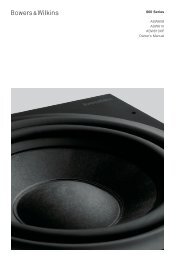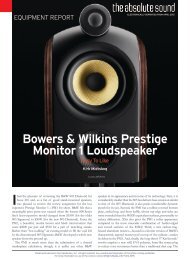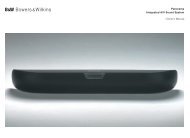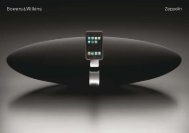CT8 XO Mk2 Manual - Bowers & Wilkins
CT8 XO Mk2 Manual - Bowers & Wilkins
CT8 XO Mk2 Manual - Bowers & Wilkins
You also want an ePaper? Increase the reach of your titles
YUMPU automatically turns print PDFs into web optimized ePapers that Google loves.
To set this curve as a multiplier, press the F5 key. In this dialog box, select<br />
the file you just saved (Average_resp) and, under ‘Compensation of<br />
Level’, check the ‘Tune EQ (multiply)’ box as shown (figure 26). This<br />
curve is now the reference and all subsequent measurements will be<br />
multiplied by this response.<br />
Click OK. The graphs will change, but ignore these changes.<br />
We now need to set division by the measurement performed in this last<br />
position with no equalisation (R n ).<br />
Press Ctrl + F and make sure this last measurement is selected as shown<br />
in figure 27 (in this example #10 was the last measurement position and<br />
that is therefore set as reference).<br />
Click OK.<br />
The graphs will change, but ignore these changes.<br />
Rneq .Rm<br />
When Rmeq we = now perform another measurement with the equalisation<br />
Rn<br />
applied (Rneq ), the software will calculate the quantity:<br />
In our case the original measurement at position #10 is R n .<br />
Now it is time to clean up the display. Make sure the following button is<br />
turned off:<br />
To remove the measurements we used to make the reference, click the<br />
erase button and select the settings shown in figure 28 (this will<br />
remove all the curves in the plot and remove the measurements from<br />
memory).<br />
There will now be no plots showing on the screen. Make sure the<br />
Overlay button is in the down state.<br />
Click (or press the F2 key) to re-measure the response at the last<br />
position. This time on the screen, you will be presented with the mean<br />
response.<br />
Examine this mean response and consider the optimum target to aim for.<br />
A flat in-room response is not desirable. Studies show that a more suitable<br />
target is a response that is flat up to 100Hz and then falling uniformly by a<br />
total of 6dB by 10kHz.<br />
Tune the parametric filters first before using the low- and high-frequency<br />
contour controls.<br />
There are three filters, each having adjustable centre frequency, gain and<br />
Q. Aim to suppress peaks first. Only if there are fewer than three significant<br />
peaks should you consider filling in dips.<br />
20<br />
Figure 26<br />
Figure 27<br />
Figure 28











